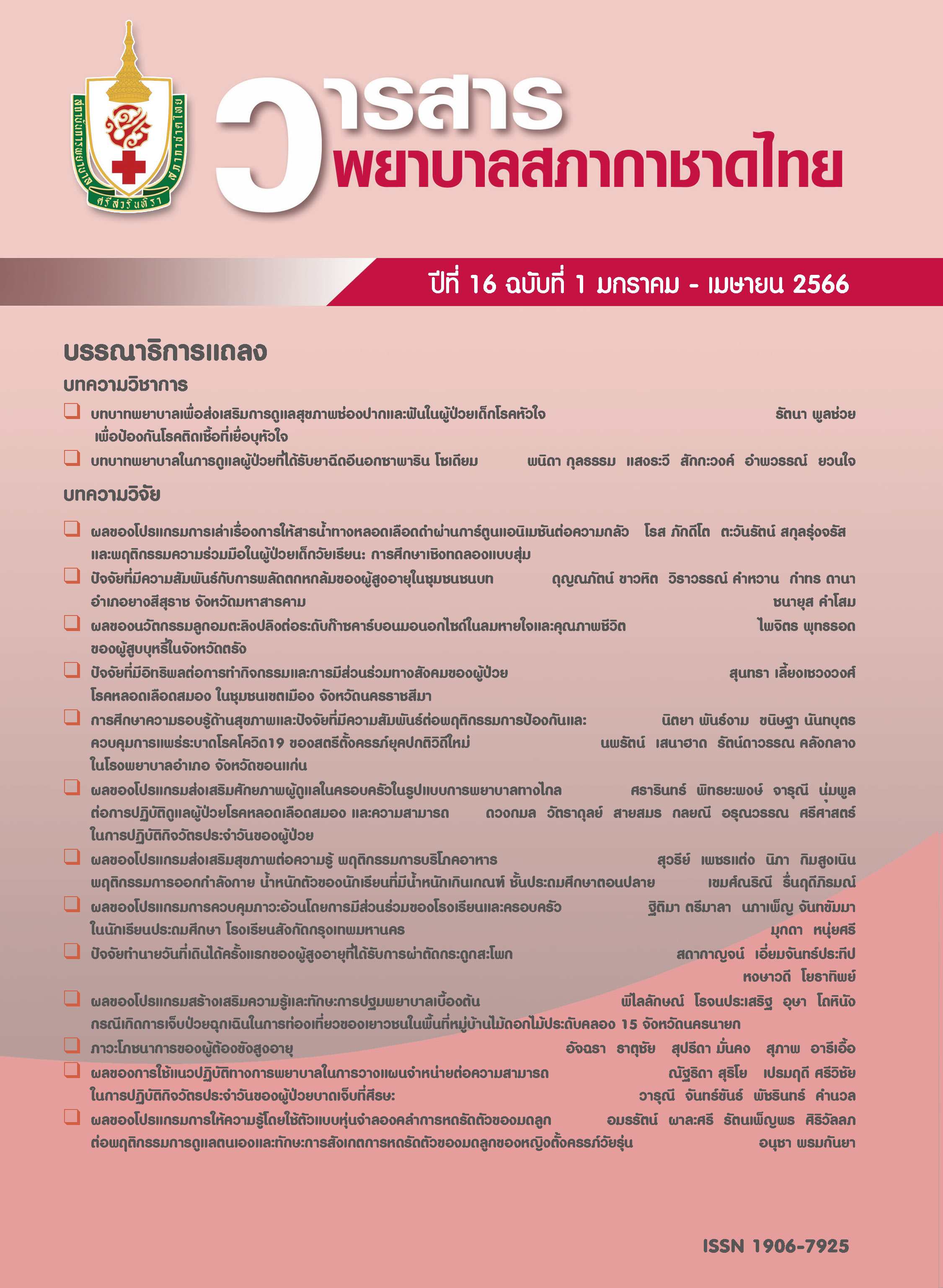Factors Affecting Physical Activity and Social Participation Among Stroke Patients Based in an Urban Community, Nakhon Rachasima Province
Keywords:
physical activity and social participation, stroke, urban communityAbstract
The purpose of this predictive correlational study was to examine the predicting factors of physical activity and social participation among stroke patients. The sample included 223 stroke patients in an urban community in Nakhon Rachasima Province. Samples were selected according to purposive criteria. Data were collected between September 2019 and May, 2021.
The research instruments consisted of a self-reporting questionnaire consisting of 1) Socio-demographic and Health Status, 2) Stroke Impact Scale, 3) Rehabilitation Self-efficacy, 4) Rehabilitation Skill Scale, 5) Environmental Factors Scale, 6) Physical Activity and Social Participation, and 7) Knowledge of Rehabilitation Scale. Data were analyzed using descriptive data and Stepwise multiple regression statistics.
The results revealed that the predictive factors on physical activity and social participation were the stroke impact score, self-efficacy, rehabilitation skill and muscle, and ability to explain at 77% of variance. These factors should be used in developing activities/ programs to increase physical activity and social participation for a rehabilitation system among stroke patients.
References
World Health Organization. World stroke day 2021 launches the precious time campaign [Internet]. 2021 [cited 2022 May 15]. Available from: https://www.who.int/ srilanka/news/detail/29-10-2021-world-stroke-day-2021-launches-the-precious-time-campaign
Singh PK. WHO South-East Asia Region: World stroke day 2021 focuses on the precious time campaign [Internet]. 2021 [cited 2022 May 15]. Available from: https:// www.who.int/srilanka/news/detail/29-10-2021
Sirindhorn National Medical Rehabilitation Institute, Department of Medicine Survices, Ministry of Health. Rehabilitation system. Nonthaburi: Sahamitr Printing and Publishing; 2017. (in Thai)
Tiamkao S. Stroke network. Thai Journal of Neurology 2017;33(1):57-60. (in Thai)
National Stroke Association. Post-stroke conditions physical [Internet]. 2016 [cited 2022 May 20]. Available from: http://www.stroke.org/we-can-help/survivors/stroke-recovery/ post- stroke-conditions/physical.
Malhotra S, Pandyan AD, Rosewilliam S, Roffe C, Hermens H. Spasticity and contractures at the wrist after stroke: time course of development and their association with functional recovery of the upper limb. Clin Rehabil 2011;25(2):184-91.
World Health Organization. International classification of functioning, disability and health ICF [Internet]. 2001 [cited 2022 Jul 15]. Available from: https://www.who.int/ standards/classifications/international-classification-of-functioning-disability-and-health.
Schuler J, Wolff W, Pfeifer J, Rihm R, Reichel J, Rothacher G, et al. The role of perceived energy and self-beliefs for physical activity and sports activity of patients with multiple sclerosis and chronic stroke. Front Psychol 2021;28(11):570221.doi: 10.3389/fpsyg.2020.570221
Phinyo P, Phinyo K, Limtragool P, Tiamkao S, Worawong S, Chuasuan W, et al. Care improvement for patients with stroke through community participation. Songklanagarind Journal of Nursing 2015;35(2):93-111. (in Thai)
Caetano LCG, Pacheco BD, Samora GAR, Teixeira-Salmela LF, Scianni AA. Self-efficacy to engage in physical exercise and walking ability best predicted exercise adherence after stroke. Stroke Res Treat 2020;2020:2957623. doi: 10.1155/2020/2957623.
Cael S, Decavel P, Binquet C, Benaim C, Puyraveau M, Chotard M, et al. Stroke impact scale version 2: validation of the french version. Phys Ther 2015;95(5):778-90. doi: 10.2522/ptj.20130012.
English C, Manns P, Tucak C, Bernhardt J. Physical activity and sedentary behaviors in people with stroke living in the community: a systematic review. Phys Ther 2014;94(2):185-96. doi: 10.2522/ptj.20130175
Pauly T, Ashe MC, Murphy R, Gerstorf D, Linden W, Madden KM, et al. Active with whom? with whom? Examining the social context of physical activity in individuals after stroke and their partners. Front Public Health 2021;9:754046. doi: 10.3389/ fpubh.2021.754046.
Thilarajah S, Mentiplay BF, Bower KJ, Tan D, Pua YH, Williams G, et al. Factors associated with post-stroke physical activity: a systematic review and meta-analysis. Arch Phys Med Rehabil 2018;99(9):1876-89. doi: 10.1016/j.apmr.2017.09.117.
Douiri A, Rudd AG, Wolfe CDA, Prevalence of poststroke cognitive impairment. Stroke 2013;44(1):138-45. doi: https://doi.org/10.1161/STROKEAHA.112.670844.
Olsson OA, Persson HC, Alt Murphy M, Sunnerhagen KS. Early prediction of physical activity level 1 year after stroke: a longitudinal cohort study. BMJ Open 2017; 7(8):e016369. doi: 10.1136/bmjopen-2017-016369.
Billinger SA, Arena R, Bernhardt J, Eng JJ, Franklin BA, Johnson CM, et al. Physical activity and exercise recommendations for stroke survivors: a statement for healthcare professionals from the American Heart Association/American Stroke Association. Stroke 2014;45(8):2532-53. doi: 10.1161/STR.0000000000000022.
Gadidi V, Katz-Leurer M, Carmeli E, Bornstein NM. Long-term outcome poststroke: predictors of activity limitation and participation restriction. Arch Phys Med Rehabil 2011;92(11):1802-8. doi: 10.1016/j.apmr.2011.06.014.
Dahlan Tabah FT, Sham F, Zakaria FN, Hashim NK, Dassiman R. Factors influencing stroke patient adherence to physical activity: a systematic review. J Geront Geriatr 2020;68(3):174-9. https://doi.org/10.36150/2499-6564-389
Viktorisson A, Andersson EM, Lundstrom E, Sunnerhagen KS. Levels of physical activity before and after stroke in relation to early cognitive function. Sci Rep 2021;11(1):9078. doi: 10.1038/s41598-021-88606-9.
Downloads
Published
Issue
Section
License
Copyright (c) 2023 Srisavarindhira Thai Red Cross Institute of Nursing

This work is licensed under a Creative Commons Attribution-NonCommercial-NoDerivatives 4.0 International License.
เนื้อหาบทความหรือข้อคิดเห็นต่างๆ ในวารสารพยาบาลสภากาชาดไทยนี้ เป็นความคิดเห็นของผู้เขียนบทความ ไม่ใช่ความเห็นของกองบรรณาธิการ หรือสถาบันการพยาบาลศรีสวรินทิรา สภากาชาดไทย






